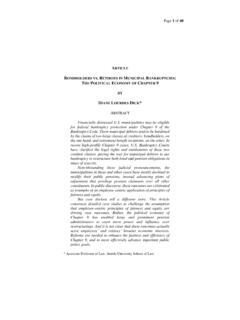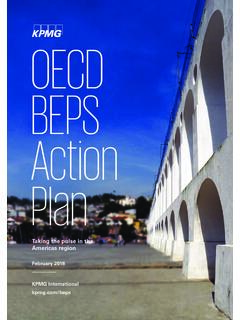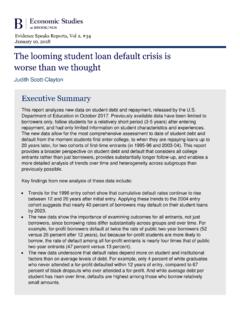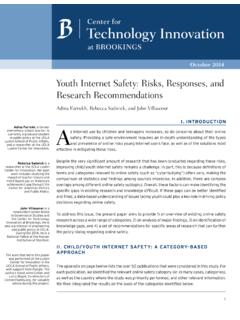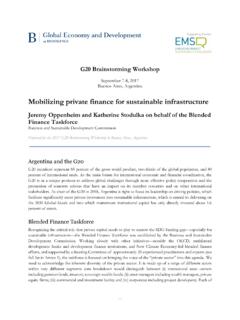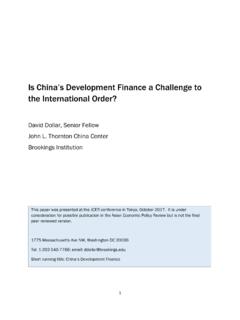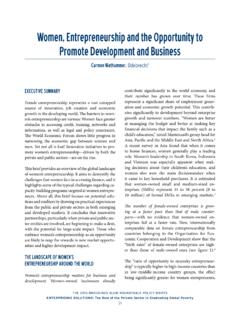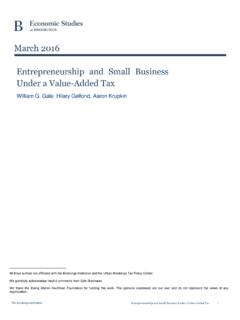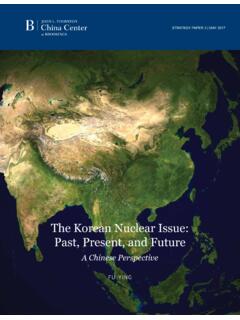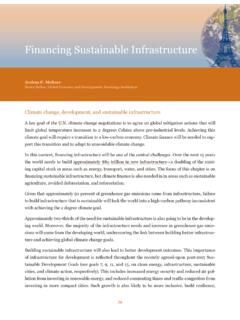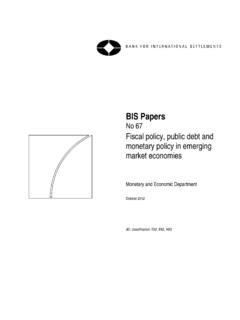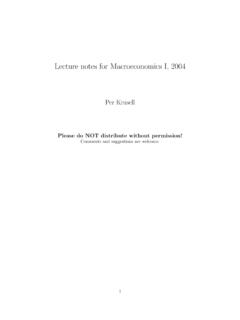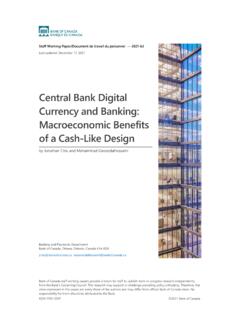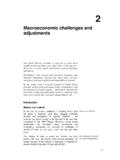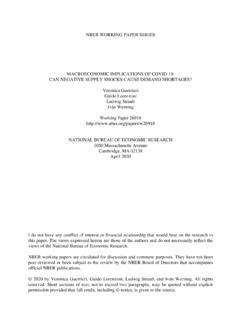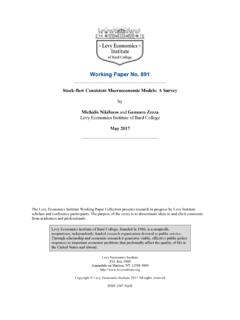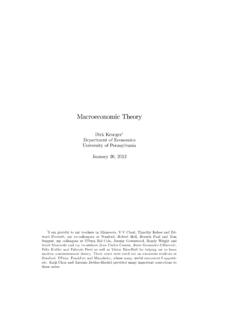Transcription of The Global Macroeconomic Impacts of COVID-19: Seven …
1 1 The Global Macroeconomic Impacts of COVID-19: Seven Scenarios* Warwick McKibbin and Roshen Fernando 2 March 2020 Abstract The outbreak of coronavirus named COVID-19 has disrupted the Chinese economy and is spreading globally. The evolution of the disease and its economic impact is highly uncertain, which makes it difficult for policymakers to formulate an appropriate Macroeconomic policy response. In order to better understand possible economic outcomes, this paper explores Seven different scenarios of how COVID-19 might evolve in the coming year using a modelling technique developed by Lee and McKibbin (2003) and extended by McKibbin and Sidorenko (2006). It examines the Impacts of different scenarios on Macroeconomic outcomes and financial markets in a Global hybrid DSGE/CGE general equilibrium model. The scenarios in this paper demonstrate that even a contained outbreak could significantly impact the Global economy in the short run. These scenarios demonstrate the scale of costs that might be avoided by greater investment in public health systems in all economies but particularly in less developed economies where health care systems are less developed and popultion density is high.
2 Keywords: Pandemics, infectious diseases, risk, macroeconomics , DSGE, CGE, G-Cubed JEL Codes: * We gratefully acknowledge financial support from the Australia Research Council Centre of Excellence in Population Ageing Research (CE170100005). We thank Renee Fry-McKibbin, Will Martin, Louise Sheiner, Barry Bosworth and David Wessel for comment and Peter Wilcoxen and Larry Weifeng Liu for their research collaboration on the G-Cubed model used in this paper. We also acknowledge the contributions to earlier research on modelling of pandemics undertaken with Jong-Wha Lee and Alexandra Sidorenko. Australian National University; the Brookings Institution; and Centre of Excellence in Population Ageing Research (CEPAR) Australian National University and Centre of Excellence in Population Ageing Research (CEPAR) 2 1. Introduction The COVID-19 outbreak (previously 2019-nCoV) was caused by the SARS-CoV-2 virus. This outbreak was triggered in December 2019 in Wuhan city in Hubei province of China.
3 COVID-19 continues to spread across the world. Initially the epicenter of the outbreak was China with reported cases either in China or being travelers from China. At the time of writing this paper, at least four further epicenters have been identified: Iran, Italy, Japan and South Korea. Even though the cases reported from China are expected to have peaked and are now falling (WHO 2020), cases reported from countries previously thought to be resilient to the outbreak, due to stronger medical standards and practices, have recently increased. While some countries have been able to effectively treat reported cases, it is uncertain where and when new cases will emerge. Amidst the significant public health risk COVID-19 poses to the world, the World Health Organization (WHO) has declared a public health emergency of international concern to coordinate international responses to the disease. It is, however, currently debated whether COVID-19 could potentially escalate to a Global pandemic.
4 In a strongly connected and integrated world, the Impacts of the disease beyond mortality (those who die) and morbidity (those who are incapacitated or caring for the incapacitated and unable to work for a period) has become apparent since the outbreak. Amidst the slowing down of the Chinese economy with interruptions to production, the functioning of Global supply chains has been disrupted. Companies across the world, irrespective of size, dependent upon inputs from China have started experiencing contractions in production. Transport being limited and even restricted among countries has further slowed down Global economic activities. Most importantly, some panic among consumers and firms has distorted usual consumption patterns and created market anomalies. Global financial markets have also been responsive to the changes and Global stock indices have plunged. Amidst the Global turbulence, in an initial assessment, the International Monetary Fund expects China to slow down by percentage points compared to its initial growth target to percent, also slowing down Global growth by percentage points.
5 This is likely to be revised in coming weeks4. 4 See OECD(2020) for an updated announcement 3 This paper attempts to quantify the potential Global economic costs of COVID-19 under different possible scenarios. The goal is to provide guidance to policy makers to the economic benefits of globally-coordinated policy responses to tame the virus. The paper builds upon the experience gained from evaluating the economics of SARS (Lee & McKibbin 2003) and Pandemic Influenza (McKibbin & Sidorenko 2006). The paper first summarizes the existing literature on the Macroeconomic costs of diseases. Section 3 outlines the Global Macroeconomic model (G-Cubed) used for the study, highlighting its strengths to assess the macroeconomics of diseases. Section 4 describes how epidemiological information is adjusted to formulate a series of economic shocks that are input into the Global economic model. Section 5 discusses the results of the Seven scenarios simulated using the model.
6 Section 6 concludes the paper summarizing the main findings and discusses some policy implications. 2. Related Literature Many studies have found that population health, as measured by life expectancy, infant and child mortality and maternal mortality, is positively related to economic welfare and growth (Pritchett and Summers, 1996; Bloom and Sachs, 1998; Bhargava and et al., 2001; Cuddington et al., 1994; Cuddington and Hancock, 1994; Robalino et al., 2002a; Robalino et al., 2002b; WHO Commission on macroeconomics and Health, 2001; Haacker, 2004). There are many channels through which an infectious disease outbreak influences the economy. Direct and indirect economic costs of illness are often the subject of the health economics studies on the burden of disease. The conventional approach uses information on deaths (mortality) and illness that prevents work (morbidity) to estimate the loss of future income due to death and disability. Losses of time and income by carers and direct expenditure on medical care and supporting services are added to obtain the estimate of the economic costs associated with the disease.
7 This conventional approach underestimates the true economic costs of infectious diseases of epidemic proportions which are highly transmissible and for which there is no vaccine ( HIV/AIDS, SARS and pandemic influenza). The experience from these previous disease outbreaks provides valuable information on how to think about the implications of COVID-19 The HIV/AIDS virus affects households, businesses and governments - through changed labor supply decisions; efficiency of labor and household incomes; increased business costs and foregone investment in staff training by firms; and increased public expenditure on health care and support of disabled and children orphaned by AIDS, by the public sector (Haacker, 2004). 4 The effects of AIDS are long-term but there are clear prevention measures that minimize the risks of acquiring HIV, and there are documented successes in implementing prevention and education programs, both in developed and in the developing world.
8 Treatment is also available, with modern antiretroviral therapies extending the life expectancy and improving the quality of life of HIV patients by many years if not decades. Studies of the Macroeconomic impact of HIV/AIDS include (Cuddington, 1993a; Cuddington, 1993b; Cuddington et al., 1994; Cuddington and Hancock, 1994; Haacker, 2002a; Haacker, 2002b; Over, 2002; Freire, 2004; The World Bank, 2006). Several computable general equilibrium (CGE) Macroeconomic models have been applied to study the impact of AIDS (Arndt and Lewis, 2001; Bell et al., 2004). The influenza virus is by far more contagious than HIV, and the onset of an epidemic can be sudden and unexpected. It appears that the COVID-19 virus is also very contagious. The fear of 1918-19 Spanish influenza, the deadliest plague in history, with its extreme severity and gravity of clinical symptoms, is still present in the research and general community (Barry, 2004). The fear factor was influential in the world s response to SARS a coronavirus not previously detected in humans (Shannon and Willoughby, 2004; Peiris et al.)
9 , 2004). It is also reflected in the response to COVID-19. Entire cities in China have closed and travel restrictions placed by countries on people entering from infected countries. The fear of an unknown deadly virus is similar in its psychological effects to the reaction to biological and other terrorism threats and causes a high level of stress, often with longer-term consequences (Hyams et al., 2002). A large number of people would feel at risk at the onset of a pandemic, even if their actual risk of dying from the disease is low. Individual assessment of the risks of death depends on the probability of death, years of life lost, and the subjective discounting factor. Viscusi et al. (1997) rank pneumonia and influenza as the third leading cause of the probability of death (following cardiovascular disease and cancer). Sunstein (1997) discusses the evidence that an individual s willingness to pay to avoid death increases for causes perceived as bad deaths especially dreaded, uncontrollable, involuntary deaths and deaths associated with high externalities and producing distributional inequity.
10 Based on this literature, it is not unreasonable to assume that individual perception of the risks associated with the new influenza pandemic virus similar to Spanish influenza in its virulence and the severity of clinical symptoms can be very high, especially during the early stage of the pandemic when no vaccine is available and antivirals are in short supply. This is exactly the reaction revealed in two surveys conducted in Taiwan during the SARS outbreak 5 in 2003 (Liu et al., 2005), with the novelty, salience and public concern about SARS contributing to the higher than expected willingness to pay to prevent the risk of infection. Studies of the Macroeconomic effects of the SARS epidemic in 2003 found significant effects on economies through large reductions in consumption of various goods and services, an increase in business operating costs, and re-evaluation of country risks reflected in increased risk premiums. Shocks to other economies were transmitted according to the degree of the countries exposure, or susceptibility, to the disease.
